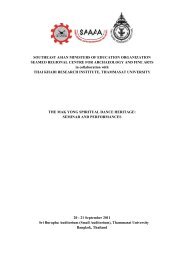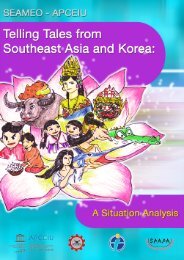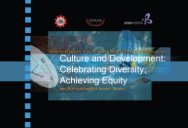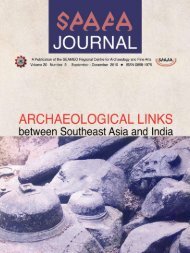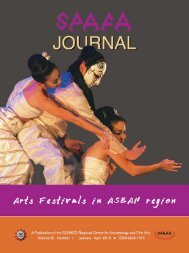on Culture & Development - Seameo-SPAFA
on Culture & Development - Seameo-SPAFA
on Culture & Development - Seameo-SPAFA
- No tags were found...
You also want an ePaper? Increase the reach of your titles
YUMPU automatically turns print PDFs into web optimized ePapers that Google loves.
project planning. Used effectively itcan help us to better understand theimportance of different groups (i.e.those whose needs and interests are apriority), and to anticipate the kind ofinfluence they may have (i.e. thosewho exert power in the decisi<strong>on</strong>makingprocess).Our starting point was to define theword stakeholder and to translate itinto the participants’ own language.On occasi<strong>on</strong>s, finding an equivalentthat was in fact inclusive provedchallenging in itself. With the agreeddefiniti<strong>on</strong>s in mind, and working insmall groups, the participants werethen asked to identify thestakeholders for a specific project. Asfar as possible we encouraged them touse projects they were working <strong>on</strong>,thus input from the different membersof the group was of a very practicalnature. A number of participantssubsequently commented <strong>on</strong> the factthat in their real work c<strong>on</strong>texts, theyhad neither the time nor the humanresources available to dedicate toc<strong>on</strong>duct such a comprehensiveanalysis. They did however recognisethe benefits of doing so.The extensive lists generated by thebrainstorming also led to aquesti<strong>on</strong>ing of the practicalities of howand when to engage with the variousstakeholder groups and to requests forclarificati<strong>on</strong> <strong>on</strong> what is meant by theterms primary and sec<strong>on</strong>darystakeholders. This, in turn, raisedissues of power and ownership. Theseissues were explored using animportance /influence grid, adaptedfrom materials for project cyclemanagement from the Tearfund. Ourmodel incorporated an idea from theOverseas <strong>Development</strong> Institute (ODI)materials which encourages the userto c<strong>on</strong>sider how best to manage therelati<strong>on</strong>ship with each stakeholder.The latter helps to prioritise efforts tobe more inclusive and encouragesthought about strategies forengagement. Both sources are listedwith the activity and in the referencesecti<strong>on</strong>.Participants were encouraged to seethe initial stakeholder analysis, whichwould take place early in the planningprocess, as something they wouldneed to revisit and build <strong>on</strong>. Often,despite the fact that the initialanalysis seeks to be exhaustive, newstakeholder groups, which may57



